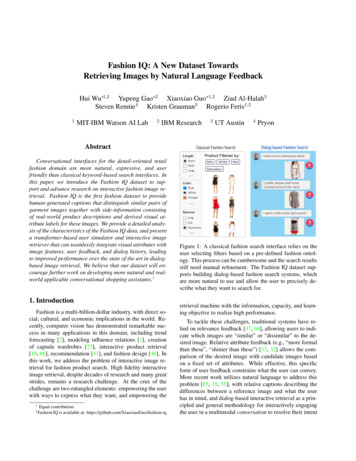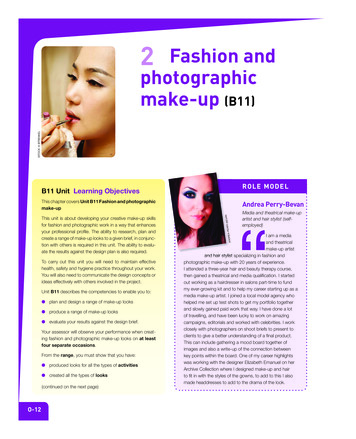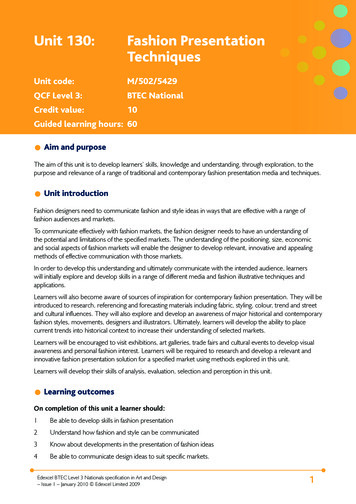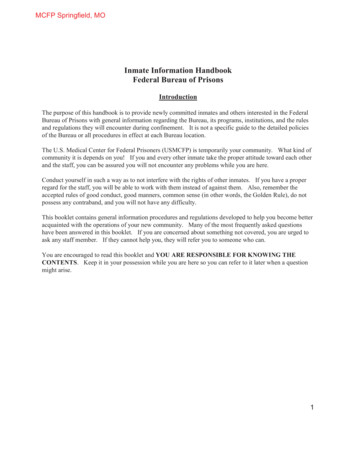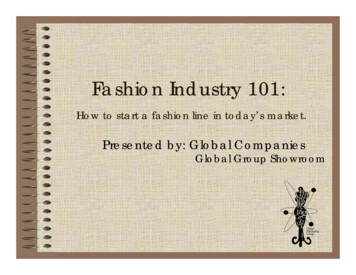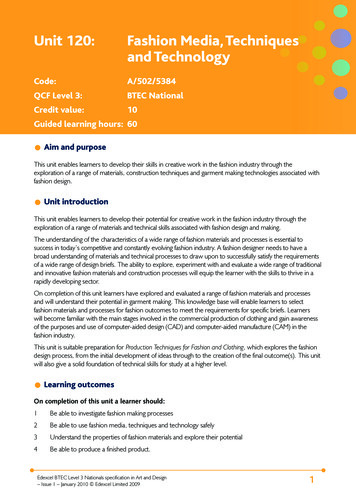
Transcription
Spotlight on StatisticsU.S. BUREAU OF LABOR STATISTICSJUNE 2012FashionThroughout history, fashion has greatly influenced the “fabric” of societies all over the world. What people wear oftencharacterizes who they are and what they do for a living. As Mark Twain once wrote, “Clothes make the man. Nakedpeople have little or no influence on society.”The fashion industry is a global industry, where fashion designers, manufacturers, merchandisers, and retailers fromall over the world collaborate to design, manufacture, and sell clothing, shoes, and accessories. The industry ischaracterized by short product life cycles, erratic consumer demand, an abundance of product variety, and complexsupply chains.In this Spotlight, we take a look at the fashion industry's supply chain—including import and producer prices,employment in the apparel manufacturing and fashion-related wholesale and retail trade industries, labor productivityin the manufacturing sector and in selected textile and apparel industries, and consumer prices and expenditures onapparel-related items.Page 1
Spotlight on StatisticsU.S. BUREAU OF LABOR STATISTICSHow Much Do Consumers Spend on Apparel?In 2010, households spent, on average, 1,700 (in nominal terms) on apparel, footwear, and related products andservices—3.5 percent of average annual expenditures. Since 1985, as a percentage of total apparel expenditures,households spent more, on average, on apparel designed for women aged 16 and over than any other apparel productor service.Page 2
Spotlight on StatisticsU.S. BUREAU OF LABOR STATISTICSEmployment in Apparel ManufacturingEmployment in the apparel manufacturing industry has declined by more than 80 percent (from about 900,000 to150,000 jobs) over the past two decades. The decline has been proportional throughout the apparel manufacturingcomponent industries.Page 3
Spotlight on StatisticsU.S. BUREAU OF LABOR STATISTICSWhere in the United States is Apparel Made?The apparel manufacturing industry includes a diverse range of establishments manufacturing full lines of ready-towear and custom apparel; apparel contractors, performing cutting or sewing operations on materials owned by others;and tailors, manufacturing custom garments for individual clients. Knitting, when done alone, is classified in thetextile mills subsector, but when knitting is combined with the production of complete garments, the activity isclassified in the apparel manufacturing industry.In 2010, there were 7,855 private business establishments in the apparel manufacturing industry, employing 157,587workers—compared with 15,478 establishments and 426,027 workers in 2001. In 2010, only two U.S. counties hadmore than 500 business establishments—Los Angeles county, California (2,509) and New York county, New York(803).Page 4
Spotlight on StatisticsU.S. BUREAU OF LABOR STATISTICSEstablishment Size - ManufacturingThe average size of establishments (the number of employees at a typical workplace such as a factory or store) hasdeclined in most apparel manufacturing industries in recent years, while it generally remained little changed infashion-related retail trade industries.In apparel manufacturing, the average number of employees per establishment declined from 28 to 20 over the 2001–2010 period, though it stayed about the same in women's and girls' cut and sew apparel manufacturing.Page 5
Spotlight on StatisticsU.S. BUREAU OF LABOR STATISTICSEstablishment Size - Retail TradeThe average number of employees per establishment in clothing stores stayed near 13 during the 2001–2010 period,though it decreased from 25 to 21 in family clothing stores.Page 6
Spotlight on StatisticsU.S. BUREAU OF LABOR STATISTICSWholesale and Retail Trade EmploymentFrom 1990 to 2011, within the wholesale trade industry, employment in industries such as jewelry and women's andchildren's clothing experienced little or no change. However, over that period, employment in the men's and boy'sclothing industry decreased 17.5 percent—from 32,000 jobs in 1990 to 26,400 jobs in 2011.Within the retail trade industry, employment in men's and women's clothing stores, shoe stores, and jewelry, luggage,and leather goods stores decreased from 1990 to 2011. In contrast, industries such as children's and infant's clothing(118.6 percent), cosmetic and beauty supply stores (82.3 percent), family clothing (63.2 percent), and clothingaccessories stores (57.0 percent) all experienced an increase in employment from 1990 to 2011. From 1990 to 2007,employment in family clothing stores increased from 273,700 jobs to 539,800 jobs, or 97.2 percent. Since 2007, thefamily clothing stores industry has lost 93,100 jobs, or 17.2 percent.Page 7
Spotlight on StatisticsU.S. BUREAU OF LABOR STATISTICSFashion-related Occupations: Employment and WagesIn 2010, earnings in many occupations associated with apparel manufacturing were typically lower than the averagefor all occupations ( 45,230). Among these occupations, fabric and apparel patternmakers—who use computer-aideddesign (CAD) software to determine the best layout of pattern pieces to minimize waste of material and to create amaster pattern for each size within a range of garment sizes—earned an annual mean wage of 44,650. There were atotal of 6,410 fabric and apparel patternmakers employed in 2010. Occupations such as textile and garment pressers,sewing machine operators, hand sewers, shoe and leather workers and repairers, and textile bleaching and dyeingmachine operators and tenders earned a mean annual wage that was more than 15,000 below the average for alloccupations. In 2010, sewing machine operators, with 142,860 workers, was the largest of these occupations.Fashion designers earned an annual mean wage of 73,930 in 2010, over 25,000 more than the average for alloccupations. There were a total of 16,010 fashion designers employed in 2010.Page 8
Spotlight on StatisticsU.S. BUREAU OF LABOR STATISTICSFashion Designers - EmploymentFashion designers create original or exclusive custom-fitted clothing (e.g. haute couture), accessories, and footwear.In doing so, they must know how to sketch designs, select fabrics and patterns, and give instructions on how to makethe products they design. Fashion designers work in wholesale or manufacturing establishments, apparel companies,retailers, theater or dance companies, and design firms.Within the United States, most fashion designers work in large cities, such as New York or Los Angeles. In May2010, almost 75 percent of all salaried fashion designers worked in New York and California. California led thenation, with a total of 4,480 employed fashion designers.Page 9
Spotlight on StatisticsU.S. BUREAU OF LABOR STATISTICSFashion Designers - Annual Mean WageAcross the country, the mean annual wage earned by fashion designers ranged from 44,100 for those employed inVirginia to 80,650 for those employed in Maine and New York.Page 10
Spotlight on StatisticsU.S. BUREAU OF LABOR STATISTICSFashion Designers - Location QuotientAmong all states, California had the highest concentration of fashion designers. In general, location quotients areratios that compare the concentration of a resource or activity, such as employment, in a defined area to that of alarger area or base. For example, location quotients can be used to compare State employment by occupation to thatof the nation.Page 11
Spotlight on StatisticsU.S. BUREAU OF LABOR STATISTICSFashion-related Occupations: Employment OutlookIn 2010, earnings in many occupations associated with apparel manufacturing were typically lower than the averagefor all occupations ( 45,230). Among these occupations, fabric and apparel patternmakers—who use computer-aideddesign (CAD) software to determine the best layout of pattern pieces to minimize waste of material and to create amaster pattern for each size within a range of garment sizes—earned an annual mean wage of 44,650. There were atotal of 6,410 fabric and apparel patternmakers employed in 2010. Occupations such as textile and garment pressers,sewing machine operators, hand sewers, shoe and leather workers and repairers, and textile bleaching and dyeingmachine operators and tenders earned a mean annual wage that was more than 15,000 below the average for alloccupations. In 2010, sewing machine operators, with 142,860 workers, was the largest of these occupations.Fashion designers earned an annual mean wage of 73,930 in 2010, over 25,000 more than the average for alloccupations. There were a total of 16,010 fashion designers employed in 2010.Page 12
Spotlight on StatisticsU.S. BUREAU OF LABOR STATISTICSMass LayoffsFrom 1996 to 2011, the U.S. apparel manufacturing industry experienced many job losses—averaging 323 masslayoff events per year. During that period, the largest number of mass layoff events occurred in 1996, when theapparel manufacturing industry initiated a total of 706—leading to the filing of 67,511 initial claims forunemployment insurance benefits.From 1996 to 2011, textile mills averaged a total of 200 mass layoff events per year, while leather and allied productmanufacturers averaged 54 events per year. In 1996, apparel, textile mill, and leather and allied product manufacturersinitiated a total of 1,040 mass layoff events—representing 7.1 percent of all mass layoff events in nonfarmestablishments.A mass layoff event occurs when fifty or more initial claims for unemployment insurance benefits are filed against anemployer during a 5-week period, regardless of the duration of the layoff.Page 13
Spotlight on StatisticsU.S. BUREAU OF LABOR STATISTICSInjury and Illness RatesA comparison of fashion-related industries shows that the rate of injuries varied among industries in 2010. Employeesin thread mills had a higher than average injury rate of 6.7 per 100 full-time workers, whereas employees in yarntexturizing, throwing, and twisting thread mills suffered fewer injuries and illnesses at 1.8 percent.In apparel manufacturing, the injury and illness rates in glove and mitten manufacturing, at 8.8 percent, was thehighest of all measured occupations related to the fashion industry. Men’s footwear (except athletic) manufacturinghad a rate of 7.6 percent, compared with other footwear manufacturing at 3.6 percent.This is an interactive chart. Click on the columns to go deeper into the category.Page 14
Spotlight on StatisticsU.S. BUREAU OF LABOR STATISTICSProductivity - Output Per HourProductivity, a key measure of efficiency, is the amount of output produced per hour of work. Labor productivity inthe U.S. manufacturing sector more than doubled from 1987 to 2010. Labor productivity also more than doubled overthat period in U.S. textile mills and nearly doubled in footwear manufacturing. Labor productivity in apparelmanufacturing followed a different pattern; it grew at about the same rate as overall manufacturing productivity from1987 to 2000 but generally declined from 2000 to 2010.Page 15
Spotlight on StatisticsU.S. BUREAU OF LABOR STATISTICSProductivity - Real OutputU.S. manufacturing output was nearly 50 percent higher in 2010 than in 1987 after adjusting for inflation, but realoutput in U.S. textile, apparel, and footwear manufacturing, declined substantially over the 1987–2010 period.Page 16
Spotlight on StatisticsU.S. BUREAU OF LABOR STATISTICSProductivity - HoursThe number of hours that U.S. manufacturing employees worked remained fairly steady from 1987 to 2000 and thendeclined by about one-third between 2000 and 2010. Hours worked in U.S. textile, apparel, and footwearmanufacturing declined nearly continuously and much more sharply than overall manufacturing hours during the1987–2010 period.Page 17
Spotlight on StatisticsU.S. BUREAU OF LABOR STATISTICSProductivity - Unit Labor CostsUnit labor costs describe the relationship between compensation and labor productivity. Increases in hourlycompensation increase unit labor costs; increases in labor productivity lower unit labor costs. Unit labor costs in U.S.manufacturing have held fairly steady since the late 1980s, meaning that manufacturers generally have been able tooffset increases in compensation costs with improved efficiency. Unit labor costs for U.S. textile manufacturers alsohave held fairly steady since the late 1980s, but unit labor costs in U.S. apparel and footwear manufacturing weresubstantially higher in 2010 than in 1987.Page 18
Spotlight on StatisticsU.S. BUREAU OF LABOR STATISTICSConsumer Prices in the Apparel IndustryThe Consumer Price Index for all items has risen at a much steeper rate than the indexes for apparel and shoes since1978. Prices for apparel rose 62 percent from 1978 to 1998, declined somewhat through 2005, and have been fairlysteady in recent years. Prices for footwear followed a similar pattern as apparel from 1978 to 2004, and footwearprices have increased somewhat more rapidly since 2004.Consumer prices for men’s and boys’ apparel rose at somewhat faster rate than prices for women’s and girls’ apparelfrom 1978 to 1998. Prices for both categories declined somewhat through 2007 before leveling off in recent years.Prices for men’s and women’s footwear followed similar patterns as prices for apparel.Consumer prices for infants’ and toddlers’ apparel rose about 69 percent from 1978 to 2000 and have generallydeclined since then.Page 19
Spotlight on StatisticsU.S. BUREAU OF LABOR STATISTICSPage 20
Spotlight on StatisticsU.S. BUREAU OF LABOR STATISTICSProducer Prices in Apparel-related IndustriesWhen shopping for clothing, shoes, and accessories in retail stores or over the Internet, a consumer’s first thoughtabout price is most likely not about the price exchange that occurs before the item is available at the retail level,although that transaction heavily influences the price the consumer sees. While producer prices for selected fashionrelated industries have trended higher since December 2003, the Producer Price Index (PPI) for fabric mills, a majorcomponent in textile-related production, increased significantly from October 2010 until September 2011. Incomparison, producer price increases for other industries such as footwear manufacturing and for accessories andother apparel were more muted until December 2011, when their rates of increase started to accelerate.Page 21
Spotlight on StatisticsU.S. BUREAU OF LABOR STATISTICSImport Prices in Apparel-related IndustriesHave you ever wondered about the journey your clothes, shoes, and accessories traveled before these items found ahome in your closet? Chances are your wardrobe includes many import components from across the globe. FromDecember 2010 to February 2011, import prices for fabric mill products increased sharply and have continued toincrease. Import prices for apparel accessories and other apparel manufacturing were higher than footwearmanufacturing from September 2007 until October 2011, when footwear prices overtook apparel accessories andother apparel and have remained steady.Page 22
Spotlight on StatisticsU.S. BUREAU OF LABOR STATISTICSCompensation for U.S. and Foreign Apparel ManufacturersIn 2007, among those countries studied by the Bureau of Labor Statistics, Germany had the highest hourlycompensation costs within the apparel manufacturing industry. The Philippines, with compensation costs at 88 centsper hour, had the lowest among those countries studied.From 2006 to 2007, with the exception of Taiwan and Japan, hourly compensation costs increased in all countriesstudied—including the United States. From 2002 to 2007, Argentina and Australia experienced the largest increase inhourly compensation costs—increasing 154 percent. Over that period, Japan experienced the smallest increase inhourly compensation costs—from 11.77 per hour to 12.70 per hour, or 8 percent. Compensation costs for theUnited States increased from 15.37 per hour to 20.42 per hour, or 33 percent.Page 23
Spotlight on StatisticsU.S. BUREAU OF LABOR STATISTICSMore BLS DataIndustries at a Glance data:Apparel manufacturing Clothing and clothing accessories stores Leather and allied product manufacturing Textile millsNote: Data in text, charts, and tables are the latest available at the time of publication. Internet links may lead tomore recent data.General Information: (202) 691-5200Media Contact: (202) 691-5902Page 24
Fashion designers create original or exclusive custom-fitted clothing (e.g. haute couture), accessories, and footwear. In doing so, they must know how to sketch designs, select fabrics and patterns, and give instructions on how to make the products they design. Fashion designers work in whol
